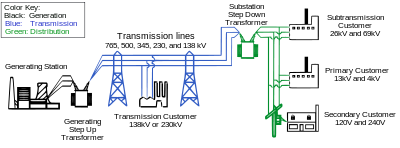The Electric Grid
The
Image above shows the three basic steps involved in
providing
electricity to your home, office, school and every other
building you may
have visited:
Each step and how it is depended on principles of physics is described in more detail below.
Generation:
- The most common method of generation of electricity is using turbines. Turbines generate electricity by moving a coil of wire between the two opposite poles of a magnet. This technique makes use of Faraday's law of inductance by changing the total amount of magnetic flux passing through the coil of wire and thus inducing an alternating current through the loop.
- Three phase Alternating current is generated by spinning three loops around the same magnetic field and orientating such that the induced EMF's or voltages produced by each loop is 120 degrees out of phase with respect to each other.
Transmission and Distribution:
- To reduce line loss, power plants generate electricity at very high voltages on the order of 11-25 kV in North America, this is then increased to even higher voltages depending on the distance the power has to travel before reaching the end user. Transformers work on the principle of mutual inductance. They consist of two coils, the primary (input) and the secondary (output) coil, depending on whether the transformer is designed to step up or step down the input voltage, the secondary coil has a smaller or larger number of turns. Thus, varying the magnetic flux and in effect changing the voltage across the secondary coil.

The above equation shows the relation between the number
of turns of a coil of wire and the change rate of change
in magnetic flux which causes a potential difference/
current across the coil. This is the basic equation used
by transformer designers to correctly design the ratio of
coils.
